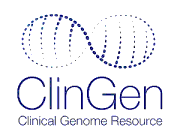The ClinGen Evidence Repository is an FDA-recognized human genetic variant database containing expert-curated assertions regarding variants' pathogenicity and supporting evidence summaries.
[Disclaimer]
- Gene label mismatch: RPE65 vs undefined
- Gene obtained from curated document aligns with the Allele Registry but not with ClinVar data
- No CSPEC computed assertion could be determined for this classification!
Variant: NM_000329.3(RPE65):c.1440AGA[1] (p.Glu481del)
- Curation Version - 1.0
- Curation History
- JSON LD for Version 1.0
CA523749345
973961 (ClinVar)
Gene: RPE65
Condition: RPE65-related recessive retinopathy
Inheritance Mode: Autosomal recessive inheritance
UUID: ae504942-bc6d-4d65-b6d7-87e2b89ef68a
Approved on: 2025-06-11
Published on: 2025-06-11
HGVS expressions
NM_000329.3:c.1440AGA[1]
NM_000329.3(RPE65):c.1440AGA[1] (p.Glu481del)
NC_000001.11:g.68431075_68431077del
CM000663.2:g.68431075_68431077del
NC_000001.10:g.68896758_68896760del
CM000663.1:g.68896758_68896760del
NC_000001.9:g.68669346_68669348del
NG_008472.1:g.23888_23890del
NG_008472.2:g.23888_23890del
ENST00000262340.6:c.1443_1445del
ENST00000262340.5:c.1443_1445del
NM_000329.2:c.1443_1445del
NM_000329.3:c.1443_1445del
More
Evidence submitted by expert panel
The information on this website is not intended for direct diagnostic use or medical decision-making without review by a genetics professional. Individuals should not change their health behavior solely on the basis of information contained on this website. If you have questions about the information contained on this website, please see a health care professional.
